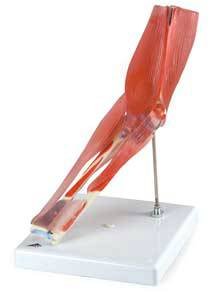Home » Hospital & Durable Medical Equipment » Using a Human Elbow Joint Model in Your Medical Practice » Using a Human Elbow Joint Model in Your Medical Practice
Using a Human Elbow Joint Model in Your Medical Practice
The elbow is one of the most commonly injured joints in the arm. It is a hinge joint that works to allow the arm to flex up and straighten, but only to a specific point. Unlike a ball joint such as a hip joint or ankle, a hinge joint is only designed to move in one direction, basically open or closed. With hyper or over extension, lateral movement or pulling on the joint severe injury can and will occur. Having a human elbow joint model in your emergency room or patient consult room can help in explaining just what type of injury has occurred and what needs to be done to correct the problem.
The most common elbow injuries include fractures, which are breaks in the bones of the elbow, as well as tendonitis, dislocation, infection and arthritis. In addition there are a number of nerves and arteries that go through the elbow joint, which can lead to problems with blood circulation, numbness and chronic pain. Being able to show a human elbow joint model to the patient can take all the mystery out of what you are trying to do as the physician. It can also allow the patient to clearly see where an injury occurred, what the injury has done to the normal functioning of the elbow and why treatment is important.
There are different types of human elbow joint model options to consider. One very popular human elbow joint model for patient work as well as teaching and research work is the full muscled elbow model. This unique model is a replica of the human arm from the bicep area through to the hand. It includes the muscles of the upper arm that are often linked to problems with pain and swelling due to hyperextension, strains and ligament damage. The muscles are accurate in their representation and are overlaying the underlying bones. Ligaments or tendons are in their correct position, helpful in describing and demonstrating how pain and movement problems occur.
The bones are accurate with regards to size for an average adult. The tendons show the attachment to the wrist with information provided on the card displayed behind the life sized model. The elbow is in a slightly bend position that clearly shows how the hinge joint functions. The phalanges or finger bones are also included in the model, perfect to demonstrate range of motion considerations for the hand after an elbow injury occurs. The bones on a human elbow joint model are very realistic in appearance and color and are great for teaching and discussion purposes.
Another type of human elbow joint model is a specific model that just includes the hinge joint itself. These smaller sized models, typically measuring about 81/2 inches in length compared to 19 inches for the full arm and elbow model are small and easy to display on a shelf or desk. These models are simple yet very accurate, perfect for working with patients and students alike. Most human elbow joint model options will show the right arm, however it may be possible to find left elbow models as well.
MSEC remains dedicated to providing the very best and the very latest in medical supplies and equipment. We never cease to be on the lookout for the latest innovation that will benefit both our many clients and the patients they dedicate their lives to caring for. If you have any difficulty finding your choices in our vast inventory, call our customer service at 1-877-706-4480 to speed up your order or to make a special request. We are always happy to help you.













 Unit: single
Unit: single




